
Polemonium reptans is a perennial herbaceous plant native to eastern North America. Common names include spreading Jacob's ladder, creeping Jacob's ladder, false Jacob's ladder, abscess root, American Greek valerian, blue bells, stairway to heaven, and sweatroot.
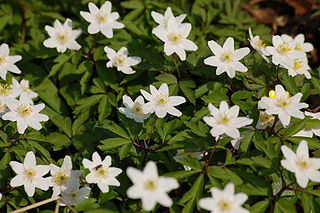
Anemonoides nemorosa, the wood anemone, is an early-spring flowering plant in the buttercup family Ranunculaceae, native to Europe. Other common names include windflower, European thimbleweed, and smell fox, an allusion to the musky smell of the leaves. It is a perennial herbaceous plant growing 5–15 cm (2–6 in) tall.
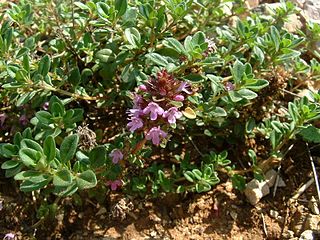
Thymus serpyllum, known by the common names of Breckland thyme, Breckland wild thyme, wild thyme, creeping thyme, or elfin thyme, is a species of flowering plant in the mint family Lamiaceae, native to most of Europe and North Africa. It is a low, usually prostrate subshrub growing to 2 cm (1 in) tall with creeping stems up to 10 cm (4 in) long. The oval evergreen leaves are 3–8 mm long. The strongly scented flowers are either lilac, pink-purple, magenta, or a rare white, all 4–6 mm long and produced in clusters. The hardy plant tolerates some pedestrian traffic and produces odors ranging from heavily herbal to lightly lemon, depending on the variety.

Mitchella repens is the best known plant in the genus Mitchella. It is a creeping prostrate herbaceous woody shrub occurring in North America belonging to the madder family (Rubiaceae).
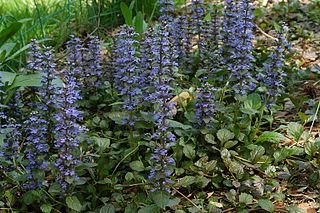
Ajuga reptans is commonly known as bugle, blue bugle, bugleherb, bugleweed, carpetweed, carpet bugleweed, and common bugle, and traditionally however less commonly as St. Lawrence plant. It is an herbaceous flowering plant in the mint family Lamiaceae, native to Europe. It is invasive in parts of North America. It is also a component of purple moor grass and rush pastures, a Biodiversity Action Plan habitat in the United Kingdom.
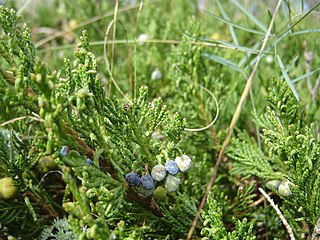
Juniperus horizontalis, the creeping juniper or creeping cedar, is a low-growing shrubby juniper native to northern North America, throughout most of Canada from Yukon east to Newfoundland, and in some of the northern United States.
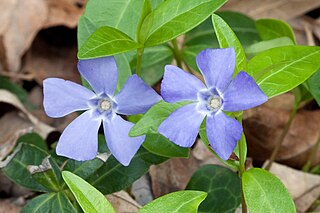
Vinca minor is a species of flowering plant in the dogbane family, native to central and southern Europe, from Portugal and France north to the Netherlands and the Baltic States, east to the Caucasus, and also southwestern Asia in Turkey. Other vernacular names used in cultivation include small periwinkle, common periwinkle, and sometimes in the United States, myrtle or creeping myrtle.
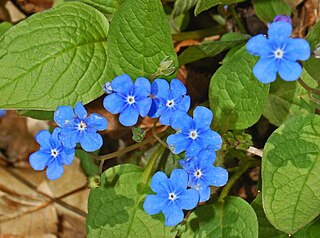
Omphalodes verna, the creeping navelwort or blue-eyed-Mary, is a rhizomatous herbaceous perennial plant in the genus Omphalodes belonging to the family Boraginaceae.

Vinca major, with the common names bigleaf periwinkle, large periwinkle, greater periwinkle and blue periwinkle, is a species of flowering plant in the family Apocynaceae, native to the western Mediterranean. Growing to 25 cm (10 in) tall and spreading indefinitely, it is an evergreen perennial, frequently used in cultivation as groundcover.

Vinca herbacea, with common name herbaceous periwinkle, is a flowering plant native to eastern and southeastern Europe, from Austria south to Greece, and east to the Crimea, and also in northern Western Asia, in the Caucasus and Alborz mountains.

Striga asiatica, the Asiatic witchweed or the red witchweed, is a hemiparasitic plant in the family Orobanchaceae. It is native to Asia and sub-Saharan Africa, but has been introduced into other parts of the world including Australia and the United States. Asiatic witchweed is a serious agricultural pest, as it parasitises important crop species, including corn, rice, sorghum, and sugar cane, often causing substantial yield reductions.

Saxifraga stolonifera is a perennial flowering plant known by several common names, including creeping saxifrage, strawberry saxifrage, creeping rockfoil, Aaron's beard, mother of thousands, roving sailor, and strawberry begonia or strawberry geranium.

Pachysandra terminalis, the Japanese pachysandra, carpet box or Japanese spurge, is a species of flowering plant in the boxwood family Buxaceae, native to Japan, Korea and China and introduced to eastern North America. It is a slow-growing, spreading evergreen perennial growing to 10 cm (4 in) tall by 60 cm (24 in) broad, with alternate, simple, glossy leaves, and creeping stems. The leaves may yellow in direct sunlight or in winter. When growing in a spreading mass of many plants, a dense cover is formed.

Liriope spicata is a species of low, herbaceous flowering plant from East Asia. Common names include creeping lilyturf, creeping liriope, lilyturf, and monkey grass. This perennial has grass-like evergreen foliage and is commonly used in landscaping in temperate climates as groundcover. Creeping lilyturf has white to lavender flowers which produce single-seeded berries on a spike in the fall. It is one of the most popular groundcovers in the southeastern United States and areas with a similar climate.

Senecio tamoides, also known as Canary creeper, false grapevine, and parlor ivy, is a climbing member of the genus Senecio of the family Asteraceae that is native to Southern Africa. It is used as an ornamental plant for its showy yellow, daisy-like flowers in late autumn through to winter.

Mesembryanthemum cordifolium, formerly known as Aptenia cordifolia, is a species of succulent plant in the iceplant family. It is a creeping plant that forms a carpet of flat-growing perennial herbs in groups on the ground from a base. Genus name means middle-embryo flower in reference to the position of the ovary in the flower. The specific epithet is derived from Latin for heart-shaped leaves.

Liriope muscari is a species of flowering plant from East Asia. Common names in English include big blue lilyturf, lilyturf, border grass, and monkey grass. This small herbaceous perennial has grass-like evergreen foliage and lilac-purple flowers which produce single-seeded berries on a spike in the fall. It is invasive to North America and considered a threat to native wildlife.

Iris japonica, commonly known as fringed iris, shaga and butterfly flower, is a native of China and Japan. It is a species in the genus Iris, in the subgenus Limniris and within the Lophiris section. It is a rhizomatous perennial plant, with pale blue, lavender or white flowers with an orange or yellow crest. It is cultivated as an ornamental plant in temperate regions.

Rubus tricolor is an evergreen prostrate shrub, native to southwestern China. Leaves are dark green above, pale green below, and stems have red bristles. It has white flowers in summer and edible red fruit. It grows approximately 0.3 m (0.98 ft) high and usually forming a vigorously spreading, dense mat. In cultivation, it is mainly used as groundcover. Common names include Chinese bramble, groundcover bramble, creeping bramble, Korean raspberry, Himalayan bramble, and groundcover raspberry. In Chinese, it is called 三色莓.

Callisia repens, also known as creeping inchplant or turtle vine, is a succulent creeping plant from the family Commelinaceae. This species comes from Central and South America.






















